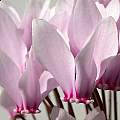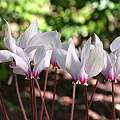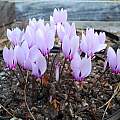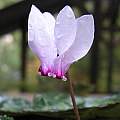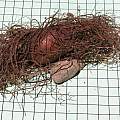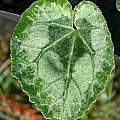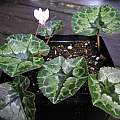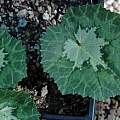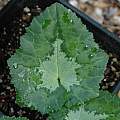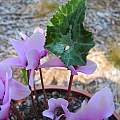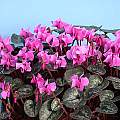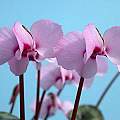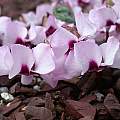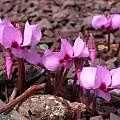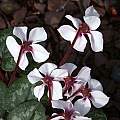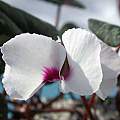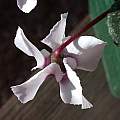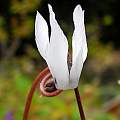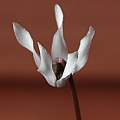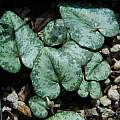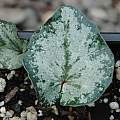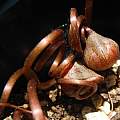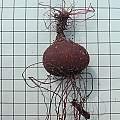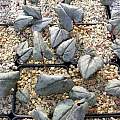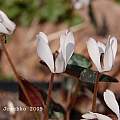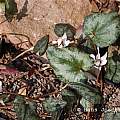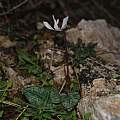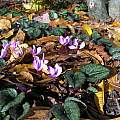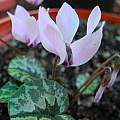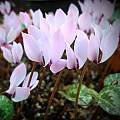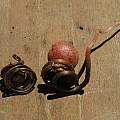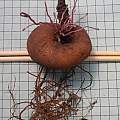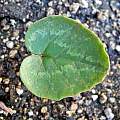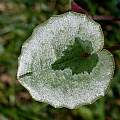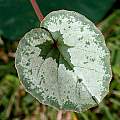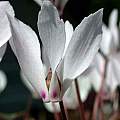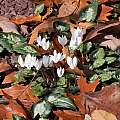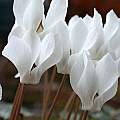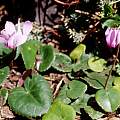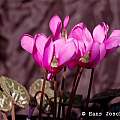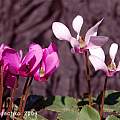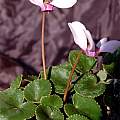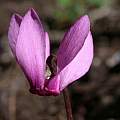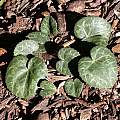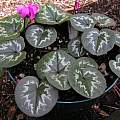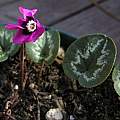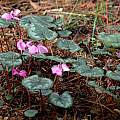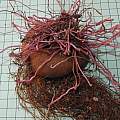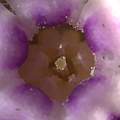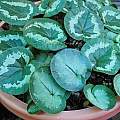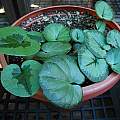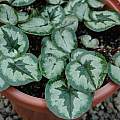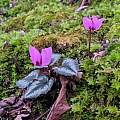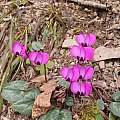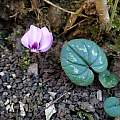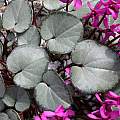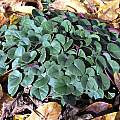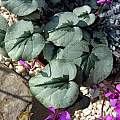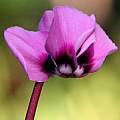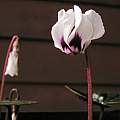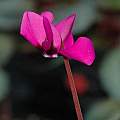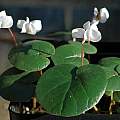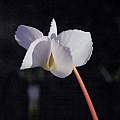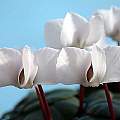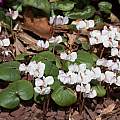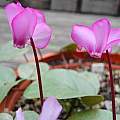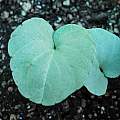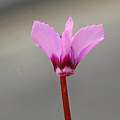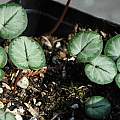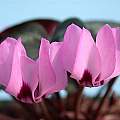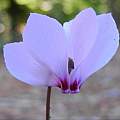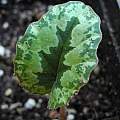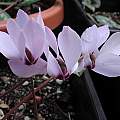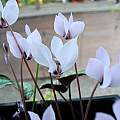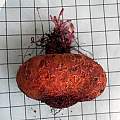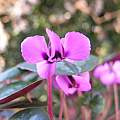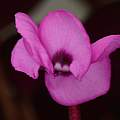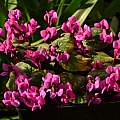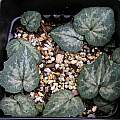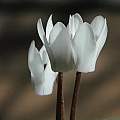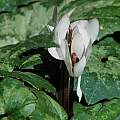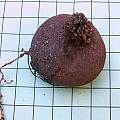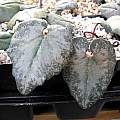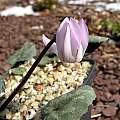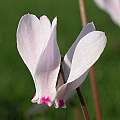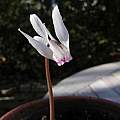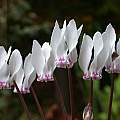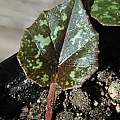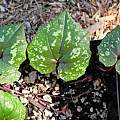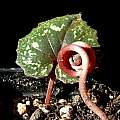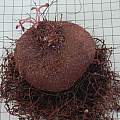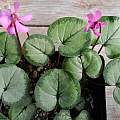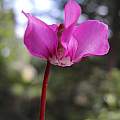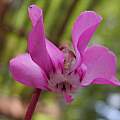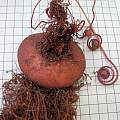Cyclamen species (and a hybrid) from a to f are found on this page.
Cyclamen africanum Boiss. & Reut. is from eastern Algeria and northwestern Tunisia, North Africa. It is in the Cyclamen hederifolium group and is very similar to Cyclamen hederifolium in appearance, but is one of the least hardy species, whereas C. hederifolium is one of the most hardy. It flowers in the fall, sometimes with leaves and sometimes not. This species has pale pink to deep pink flowers with auricles and the flowers arise erect from the tuber. Each petal has a basal purple or crimson magenta V-shaped blotch. Tubers are depressed-globose, often hollowed above, to 14 cm (5.5 in) and when mature rough and corky or flaky. Roots form all over the surface, differentiating it from Cyclamen hederifolium. It requires a dry summer dormancy, with watering commencing in late summer to fall and continuing through the growing season, and protection from the frost. Height range: 12-15 cm. The first two photos are from John Lonsdale and the next three from Mary Sue Ittner including the tuber on a 1 cm grid.
Leaves are heart-shaped to oval, leathery and bright green, sometimes grey green, with a finely to coarsely toothed margin, becoming up to 15 cm long and wide and arise directly from the tuber. Leaf patterns are variable with pale or dark marbling or a grey hastate pattern. The last photo shows a leaf that appeared to come out of the flower. Photos from Mary Sue Ittner.
Cyclamen alpinum Dammann ex Spreng., syn. Cyclamen trochopteranthum O.Schwarz, syn. Cyclamen coum ssp. trochopteranthum (O.Schwarz) Ietsw., is a species in the Cyclamen coum group from southwestern Turkey where it grows in rocky areas, deciduous woodlands, and scrub from 350-1,500 m (1,150-4,920 ft) above sea level. Flowers occur in spring and are borne with semi-mature or mature leaves, and are sweetly spice-scented and vary from pale pink to deep pink, rose pink or carmine purple with a solid deep purple-magenta blotch around the mouth. The petals are twisted, like a ship's propeller. The leaves are smallish, rounded or heart shaped, with shallow toothing and silver green markings. Tubers are depressed-globose to 5 cm (2 in), sometimes larger, and are brown, smooth and velvety when mature and root from the center of the base. This species is reasonably hardy, but dislikes wide fluctuations in moisture or temperature. Height range: 5-10 cm. Photos by John Lonsdale.
Cyclamen alpinum forma leucanthum (Grey-Wilson) Grey-Wilson, syn. Cyclamen trochopteranthum forma leucanthum Grey-Wilson, has purple-nosed white flowers. Photos from John Lonsdale.
Cyclamen balearicum Willk. is a species in the Cyclamen repandum complex from the Balearic Islands and France where it grows in shaded or semi-shaded places, in pinewoods and scrubland. It blooms in spring and has small white fragrant flowers without auricles, but with pale pink veins and leaves that are less lobed than Cyclamen repandum, with a more grey and marbled pattern. Some of the leaves are silvery grey or silver. Tubers are depressed-globose, up to 3 cm (1.2 in) with a smooth surface and thin greyish brown skin and root from the center of the base of the tuber. Height range: 2-5 cm. Photos below are from Mary Sue Ittner including the fruit and the tuber on a 1 cm grid.
The first photo was taken by John Lonsdale and the rest by Hans Joschko.
Cyclamen cilicium Boiss. & Heldr. is a relatively hardy species in the Cyclamen cilicium group that flowers in autumn, appearing with young or semi mature leaves. Most of the flowers are pink with a magenta blotch at the base of the petals and are without auricles. The petals twist slightly. It is easy to grow and flowers prolifically. Tubers are small and depressed-globose (up to 5.2 cm, 2 in, often smaller), smooth and velvety at maturity and root from under the base. It is endemic to southern Turkey where it grows in the shade and may receive some moisture while dormant during the long, hot summers. Height range: 6-12 cm. Photos by John Lonsdale and Mary Sue Ittner. The fifth photo shows the fruit and the last shows the tuber on a 1 cm grid. It is a bit larger than the size usually attributed to it.
Leaves are longer than wide, heart shaped with a narrow sinus at the base and margins that can be shallowly toothed. Variations in color are deep green with an irregular hastate grey, grey-green or white pattern, or pale green suffused with purple beneath. Photos by Mary Sue Ittner and John Lonsdale.
There is a pure white form (labeled forma album or 'Album'). Although rare in the wild, the white flowers come true from seed although the leaf patterns are variable. Photos from John Lonsdale.
Cyclamen colchicum (Albov) Correvon is found in a limited region of the Caucasus Mountains, in woodland on dolomitic limestone. It was once thought to be a subspecies of Cyclamen purpurascens and is in this group, but it has thicker and more leathery leaves with veins sunk into the leaf surface and finely-toothed horny margins which give it a beaded effect. It has carmine-pink flowers which appear from July to October with the leaves. They are smaller and more rounded towards the mouth. Tubers are irregular, nobby when mature and root unevenly over the sides and base. Height: to about 10 cm. Photos by Hans Joschko and John Lonsdale.
Cyclamen coum Mill. is one of the hardier species and one of the easiest to grow. It flowers in early winter or spring and is from the mountains of Bulgaria, Turkey and Lebanon, usually in shaded places. Tubers are rounded in outline and compressed, to 6.5 cm (2.6 in), with a smooth and velvety coat and root from the center of the base. Leaf color can be shiny green or silvery or have silvery-green zones as in the leaves pictured below. They can be grown from seeds. Jim Shields sows the seeds in late fall using various germination regimes but found that the seeds all germinated at the same time, regardless of planting time or seed treatments. See Cyclamen Compared for comparison with Cyclamen hederifolium.
Four photos by Mary Sue Ittner. The second picture shows a flower (formed in October) that never turned down and the third photo shows a plant growing in the ground and blooming more normally in January. The fourth shows a tuber on a 1 cm grid. The last photo by David Pilling.
Photos below from Mary Sue Ittner show variation in leave patterns of seed grown plants.
Cyclamen coum ssp. caucasicum (K.Koch) O.Schwarz, syn. Cyclamen coum var. caucasicum (K.Koch) Meikle, has heart shaped leaves that are longer than broad and not lobed but often slightly toothed or scalloped, normally marbled above. Flowers are pale to deep pink and eyes are rarely white. Distribution is in northeastern Turkey, the Caucasus and Trans-Caucasus. In the Caucasus there are a variety of different forms with different sized flowers. Photos from iNaturalist were taken by Grigory Evtukh, ksue_b and Alexey P. Seregin in Azerbaijan and Russia and shared under a CC BY-NC license.
Cyclamen coum ssp. coum has kidney-shaped to rounded leaves with untoothed or slightly toothed margins. Flowers are small with white or very pink pale eyes at the base of the petals. Photos by John Lonsdale and Mary Sue Ittner.
Cyclamen coum ssp. coum forma albissimum R.H.Bailey has pure white flowers without any markings. Plants of the World Online in 2022 is not separating this from ssp. coum. 'Golan Heights', collected in Israel, has plain, unmarked leaves. Photos by Mary Sue Ittner and John Lonsdale.
Cyclamen coum ssp. coum 'Pewter Group' may have started with a cross from Cyclamen coum 'Nymans' and C. coum 'EKB 371'. These plants have been crossed a number of times with the results of plants with pewter leaves and pale pink to magenta flowers. The two photos from Mary Sue Ittner are of a plant received as 'Nymans' and is probably a cross from the original.
Cyclamen coum ssp. coum Silver leaved Group includes 'Tilebarn Graham' a selection with rounded leaves and small pink flowers with a deep magenta blotch at the base of each petal. The petals are narrow and twisted. Photos from Mary Sue Ittner.
Cyclamen coum ssp. elegans (Boiss. & Buhse) Grey-Wilson, syn. Cyclamen elegans, has heart-shaped leaves that are marbled above usually with a hastate pattern. Both the leaves and the larger flowers are much more pointed than other subspecies of Cyclamen coum. The flowers are mid pink with a darker pink blotch, with pale to deep pink eyes. It is from Northern Iran where it grows in forests at low elevations. It is rare in cultivation and probably less hardy. Photos by John Lonsdale and Mary Sue Ittner. The last shows a tuber on a 1 cm grid.
Cyclamen coum 'Yayladagi' received as seed from a fellow Cyclamen grower. Yayladagi is a little town on the border of Turkey and Syria. Photo by Arnold Trachtenberg
Cyclamen creticum (Dörfl.) Hildebr. is a native of Crete where it is found in open rocky places or under bushes at elevations from 0 to 1250 m (0 to 500 ft). It is in the Cyclamen repandum group. Heart-shaped leaves are toothed and dark green splashed with silvery markings and flowers, appearing with the mature leaves, are usually white or occasionally pale pink and fragrant, twisted, without auricles at the base. Tubers are depressed globose to 4 cm (1.6 in), smooth with thin grey brown skin and root from the center of the base. This species is tender and blooms in the spring. The first four photos were taken by Mary Sue Ittner including a tuber laid on a 1 cm grid. The tuber doesn't have many roots, but looks like it roots on the side instead of the base. The last photo of leaves was taken by John Lonsdale.
Cyclamen creticum forma pallide-roseum Grey-Wilson is not recognized in 2022, but is the name used for pink-flowered forms of this species. Photo by John Lonsdale
Cyclamen cyprium Kotschy is an autumn flowering species with white fragrant flowers from Cyprus where it grows mostly in mountain woodland. Tubers are subglobose to 10 cm (4 in) with rough greyish skin when mature and root from the base, nearly always on one side. The leaves are lobed and olive green marked or splashed with grey, green or pewter. The thin small flowers are auricled with a purple or magenta M-shaped mark at the base of each petal. The pedicels coil from the top down as the fruits develop. The first photo is from Mark Smyth, the second from Arnold Trachtenberg, and the third from John Lonsdale.
Photos below were taken by Mary Sue Ittner. The first one shows an emerging new leaf, the second leaves at a later stage when the color has lightened, the third a coiling pedicel and the last photo a tuber on a 1 cm grid.
Cyclamen × drydeniae Grey-Wilson is an artificially created hybrid between Cyclamen coum and Cyclamen alpinum. The offspring generally have twisted petals. Photos by Mary Sue Ittner of plants grown from seed labeled as this hybrid showing leaves, flowers, tuber, and seed. The tuber and seed are on a 1 cm grid. It generally flowers for her in winter, but occasionally in fall or spring.
